
The Pioneer SX-9000 receiver was introduced in 1970 and was on the market until around 1973. It was one of Pioneer’s premium receivers at the time. It produces 50 watts per channel into 8 ohms. While it had all of the standard features of high end stereos of that era it also incorporated what some feel was a marketing gimmick – a reverberation amplifier. More on that later.
The SX-9000 is a very nice looking stereo. It’s front panel is clean and uncluttered. This is because most of the controls are hidden behind the hinged, flip-down door running along the bottom of the front panel.

Flip down the panel and you’ll find controls and connections for headphones, Bass and Treble, Reverb, Filters, Muting, Loudness, Tape monitor, Balance, Mode, and Mic.
Controls you would probably use more often are located to the upper right of the front panel. The volume knob is small by later standards, and controls both the master volume as well as the source volume. The source control appears to be used mainly when mixing mic with another source such as a record or tape. The master volume controls volume at the speakers. Audio Magazine had a more technical explanation of the volume controls:
“The separate “source” and master volume controls are a welcome addition from the past. We have long maintained that the incorporation of a loudness-contour circuit is somewhat meaningless unless a means is provided for adjusting the input or source level so that the so-called Fletcher-Munson loudness compensation curves (for low-level listening) can be made to correspond to their appropriate absolute levels. This dual control provides that means.“
One user stated that:
“I leave source full clockwise or close to it and then use the volume as normal. I view that source pot as a preamp output level control.”

The dial face of the SX-9000 looks great when lit. While the signal strength and FM tuning meters are remedial, their yellow backlighting, combined with the green tone color display and reverberation display, give the dial face a scientific equipment look. There are LED indicator lights for FM Stereo, AM, FM, Phono, and Aux.
Another cool feature is the red dot tuning indicator. While most receivers have a “needle” type indicator, the SX-9000 has a simple red dot. Very elegant.

As an aside, if you’re keen on cleaning up your SX-9000, be careful with the inside of the dial glass. Over the years dirt and bugs can get in there and make it unsightly and you may want to disassemble it and clean the inside of the dial glass. You can, but be careful because the the dial numbering and lettering is actually a decal that can come off if it gets wet. Some have used cotton swabs to clean around the numbers and letters with success. Just be careful. You don’t want it to look like this:
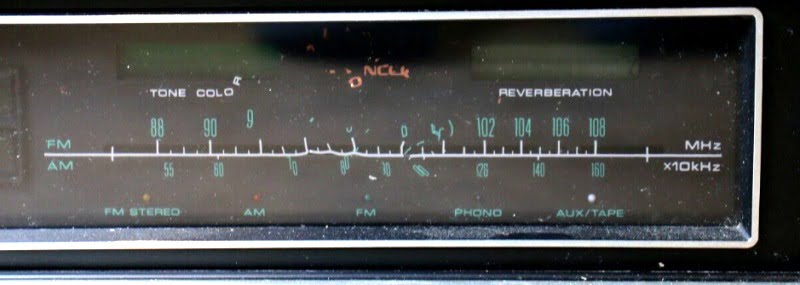
The beveled edge around the front of the wood case on the SX-9000 is very nice and adds a touch of class.
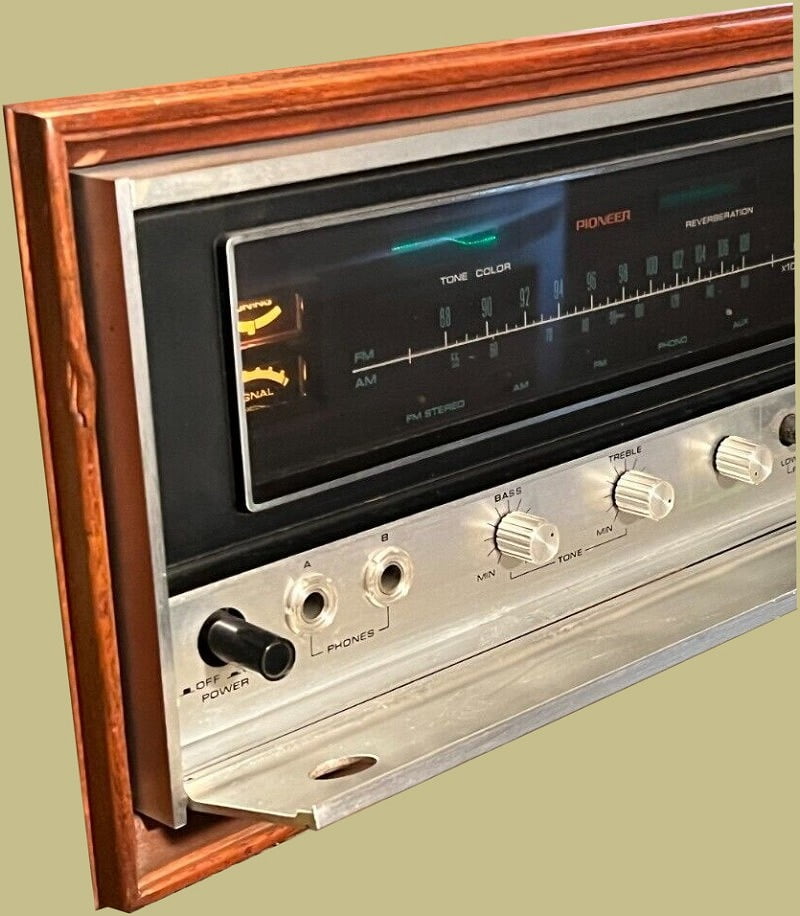
One of the main selling points of Pioneer’s SX-9000 was its Tone Color control. As you can see, it has four positions. The Vivid position emphasizes both high and low frequencies to give the music more clarity. Bass emphasizes low frequencies, Flat leaves the tone unchanged, and Soft mutes the high frequencies slightly. Of course you could achieve the same result with the regular bass and treble controls but it’s nice to have those settings readily available at the turn of a knob. Unfortunately, the SX-9000 does not have any mid-range frequency controls.
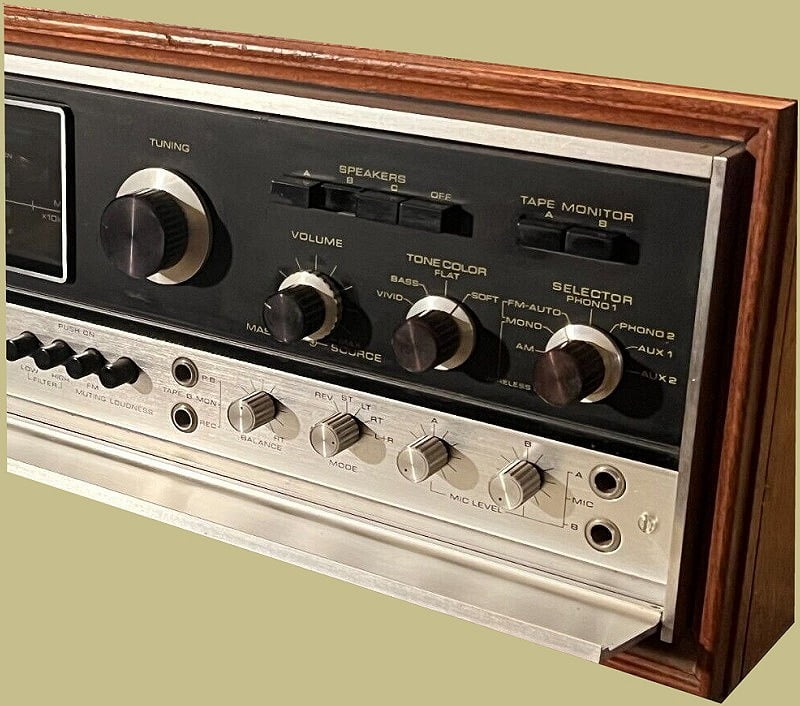
The other heavily marketed and, what some might call questionable, feature of the SX-9000 is the Reverb control. Located under the flip down panel this control increases or decreases the amount of reverberation (like echo) the unit produces. Some listeners feel that at even mid levels the reverb is so blatant that it makes music almost unlistenable. Pioneer did a great job integrating it into the stereo though and actually used a real spring reverb, similar to what you’d find in a guitar amplifier, to produce the sound. The SX-9000 does have extensive controls for mic mixing so if you were using it like a 4-track recorder then maybe the reverb would be useful.
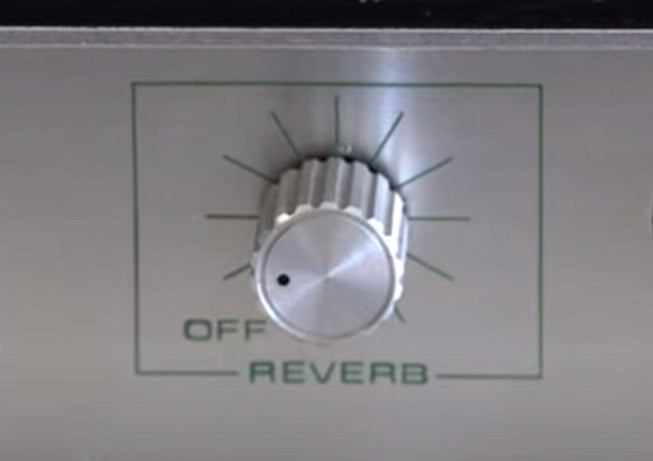
The SX-9000, at a retail price of $499.95, wasn’t really the top-of-the-line receiver in Pioneer’s lineup but it was close. That distinction went to the SX-2500 which produced 72 watts per channel and retailed for $549.95. But, the SX-2500 didn’t have tone or reverb control. The SX-990 and SX-1500 TD were also on the market at that time. A bit later Pioneer introduced the SX-828, seen in the below ad, which produced 60 WPC. It’s a little strange that Pioneer kept the SX-9000 on the market even after their new SX-X2X lineup was being advertised. That line included the SX-424, SX-525, SX-626, SX-727 and SX-828.

The SX-9000 has multiple inputs which makes it very versatile. It has two phono inputs, two tape inputs, and two mic inputs. It even has two headphone outputs. It can handle up to three sets of speakers. Not many receivers were this versatile in the early 1970’s.
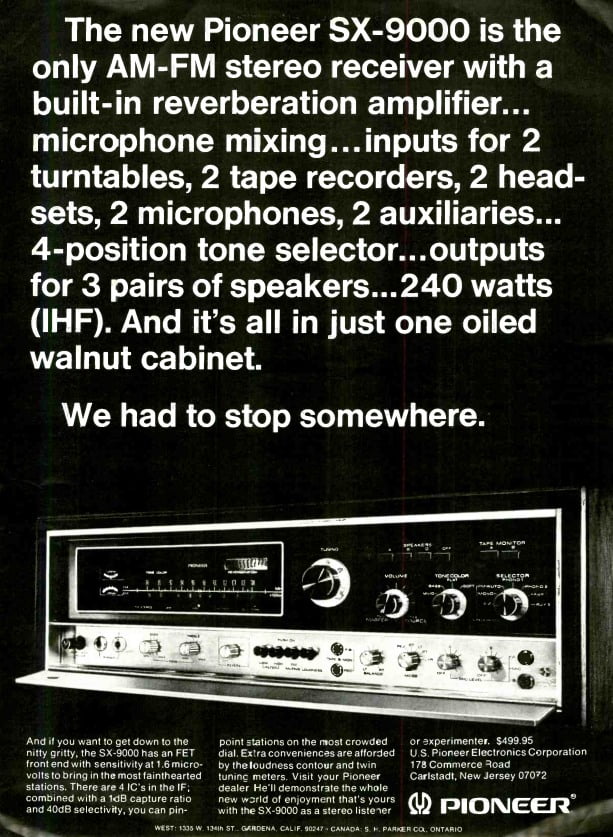
Pioneer did a good job designing and building the SX-9000 and it was a workhorse at the time. It’s capacitor coupled rather than direct coupled which some say gives it a warmer sound. I believe there are 15 circuit boards in the unit. This extra circuitry, mostly for tone and reverb controls, increases the chances of things going wrong and adds complexity to any servicing or restoration attempt.
A common problem with the SX-9000 is hum in the reverb circuit. Since the reverb circuitry is in the signal path it can add noise even when reverb is turned off. Replacement of all transistors (not just the reverb board) is usually a good idea with the SX-9000 as they seem to be more problematic than transistors in other receivers. One user made a list of transistor substitutes for the SX-9000. I haven’t verified them but the list may be a good start for someone researching what transistors to use in the SX-9000. Be sure to they will work for your application. Here are his suggestions:
“2sc458, 870, 871, 734’s can be replaced with 2sc1845 and 2sa561 with KSA992.
Main Amp:
2sc484 with ksc2073
2sa484 with ksa940
2sc627 with ksc3503
2sc870 with ksc1845“
These days it’s rather difficult to find a fully functional SX-9000 that hasn’t been extensively serviced or outright restored.
In the below picture you can see the spring reverb unit to the direct right of the two gray capacitors in the middle.
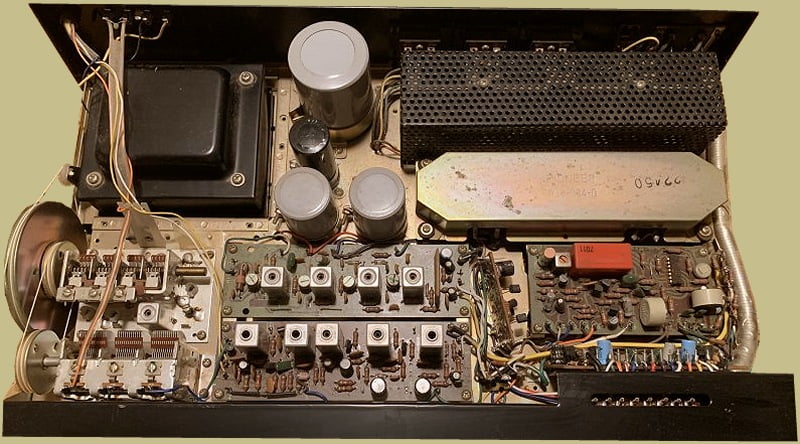
The SX-9000 has a great amplifier section and a very good pre-amp section as well. Signal-to-hum and noise levels when listening to records is excellent. Early reviewers of the SX-9000 found that they could be listening to record at “room filling” sound levels and then turn off the phono source (leaving volume at it’s previous level), put their ear right next to the speaker, and hear no hiss or hum. This implies tight and clean sound even at low volume listening.
The FM tuner in the SX-9000 is well designed and aligned. Pioneer claimed 65dB signal to noise ratio but the SX-9000 tested at 75 dB and that was through the entire FM band.

You’ll notice that the speaker connectors on the back panel are those infamous plugs that tend to get lost. If you’re looking at an SX-9000 to purchase make sure these plugs are there otherwise you’ll have to buy some. Fortunately you can usually find some on eBay. To browse speaker plugs available on eBay click HERE.
Here is the diagram for the back panel connections.
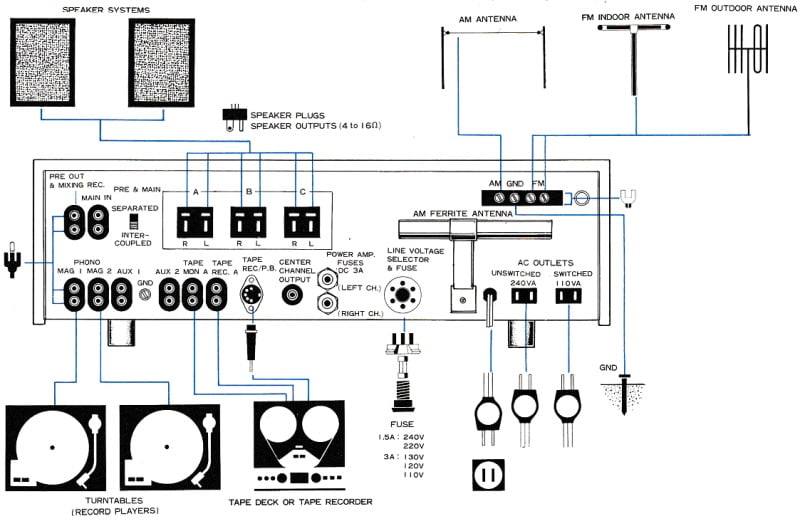
If you’re looking for knobs or other parts for your Pioneer SX-9000 you can check what’s available on eBay HERE.
The Pioneer SX-9000 is a fantastic receiver. It does a lot of things very well. The FM tuner, signal-to-noise-ratio, phono section, and amplifier section are all excellent. It may need some extensive work to replace transistors and capacitors though, which isn’t easy given the number of circuit boards in the unit. But, it’s well worth it in terms of performance. Add in the great styling and novel tone color and reverb control and it’s a winner.

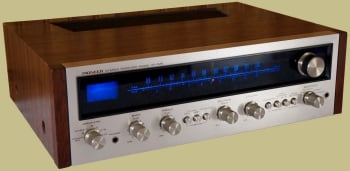
I have this beautiful pioneer receiver it sounds great I love it
This was my first audio expendure (1972) and it was, and is, a looker. Big bold and heavy. Simplistic looking with hidden complexities – behind the door. Very clean & quite. Pleasing to use due to excellent controls and tactile feedback.
The reviewer describes a “great amplifier section” but I sold this reciever because of the weak power amplfier. No real muscle to be found. When paired with the best period speakers – Infinity/Advent/Dalquist/ESS/OhmWalsh, it was unable to deliver. It was great with the Japanese speakers like Pioneer’s matching CS series (99,88,66) or Sansui/Sony/Yamaha/JVC. Real power amplification was only to be found in SAE/Dynaco/McIntosh. This was the great differential in audio of the 70’s.
Even with some operational weaknesses, Pioneer led the world with its classic reciever designs that were adopted by most every manufacturer.